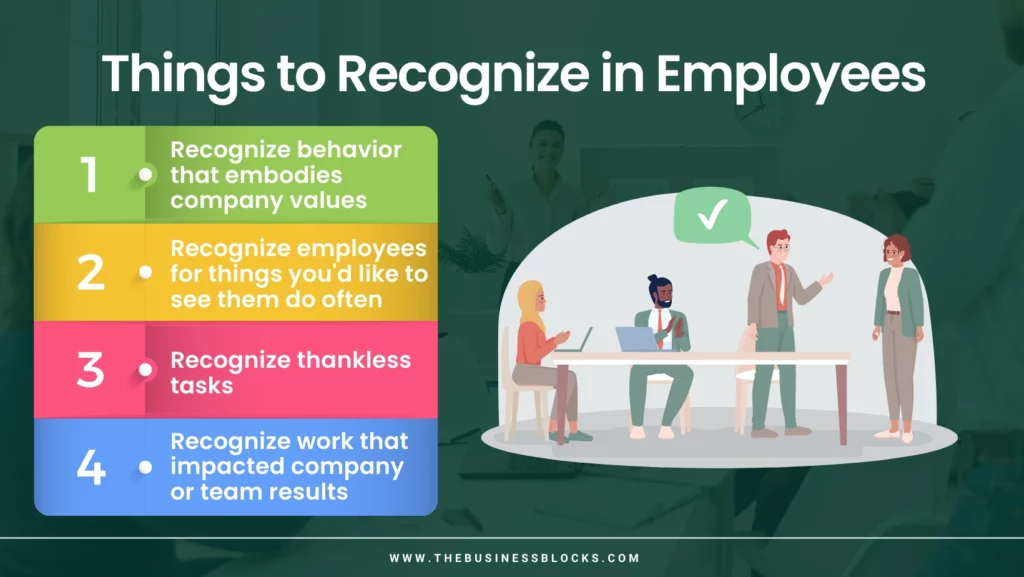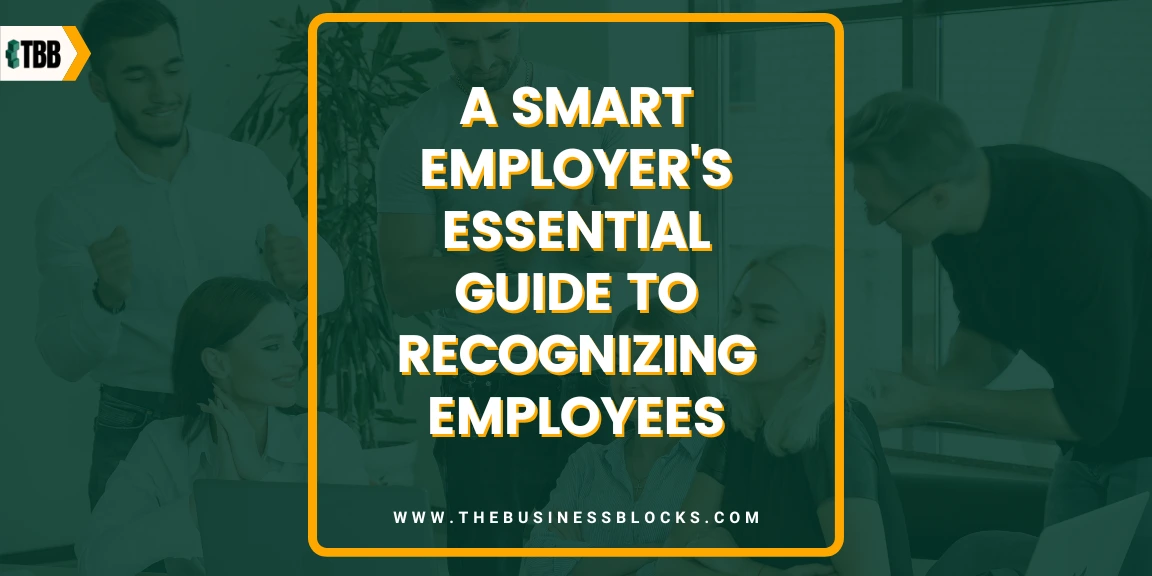Picture this: a workplace where appreciation flows freely, dedication is met with gratitude, and a culture of recognition becomes the lifeblood of success. This isn’t some far-fetched dream – it’s an achievable reality that can revolutionize your organization’s performance.
How can you do this? The answer is simple – recognizing employees. Employee recognition is acknowledging and appreciating individuals’ efforts, achievements, and contributions within an organization.
It involves a range of meaningful gestures, from simple verbal appreciation and thank-you notes to more formal recognition programs, awards, and incentives designed to validate and reinforce positive behaviors and outcomes.
Recognizing employees isn’t only about boosting morale, job satisfaction, and engagement. It also cultivates a sense of belonging, loyalty, and a drive for continued excellence in the workforce. Let’s learn everything you need to know about employee recognition in this essential guide to recognizing employees.
Looking for a way to make employees feel appreciated?

Employees are the lifeblood of any successful business, yet their efforts often go unrecognized. That’s why having an effective employee recognition program is essential. It helps create positive relationships between employers and employees, boost morale, increase engagement, and improve productivity.
Recognizing your team doesn’t have to be complicated or expensive – all it takes is a little effort and commitment from employers. Types of employee recognition programs might include awards, performance bonuses, monetary rewards, financial compensation, team challenges, and special gifts. Not only will it show you value your staff, but also help keep them motivated and inspired!
Private Recognition and Public Recognition
When designing a comprehensive employee recognition strategy, it’s crucial to consider both public and private recognition. Each type has unique benefits, pros, and cons and serves different organizational needs.
Public Recognition
Public recognition refers to acknowledging and appreciating an employee’s achievements, efforts, or contributions in a visible and shared manner. This recognition typically occurs in front of colleagues, teams, or the entire organization.
Public recognition fulfills the human need for social validation and esteem. It gives employees a sense of pride, affirmation, and belonging within the larger organizational community.
Benefits of public recognition
- Amplified impact: Public recognition has the potential to inspire and motivate not only the recognized Employee but also their peers. It creates a ripple effect by showcasing exemplary behavior or performance, encouraging others to do the same.
- Reinforces organizational values: Public recognition provides an opportunity to align employee behavior with the organization’s core values. It reinforces the desired culture and sets a positive example.
- Increased visibility and exposure: Publicly recognizing employees can raise their profile within the organization. This increased visibility leads to career growth and enhanced professional networks.
Public recognition for employees is a standard practice in most workplaces. But there are a few things about it that we must know.
While public recognition can uplift many, some may feel uncomfortable or shy away from the spotlight. It’s essential to be mindful of personal preferences and consent.
Secondly, public recognition may inadvertently create a sense of competition or resentment among employees who have not been recognized. It is crucial to balance it with a fair and inclusive approach.
Private Recognition
Private recognition involves acknowledging and appreciating an employee’s accomplishments, efforts, or contributions in a one-on-one setting, away from the eyes of others.
It fulfills the need for personal affirmation, individual connection, and a sense of intrinsic worth. It emphasizes the importance of individual contributions and creates a more intimate and confidential atmosphere.
Benefits of private recognition
- Private recognition allows employers to customize their appreciation to match each Employee’s preferences, personality, and specific achievements. This individualized approach demonstrates care and attention.
- Private recognition provides a safe and confidential space for open dialogue and feedback. It allows employees to discuss their accomplishments, challenges, and aspirations in a more personal and trusting environment.
- It’s an excellent opportunity for employers to provide constructive feedback, guidance, and mentorship.
As with public recognition, private recognition isn’t a foolproof approach either. That’s because, unlike public recognition, private recognition does not have the same level of visibility and potential for inspiring others. It may not have a widespread impact on the organizational culture or the motivation of the entire workforce.
Moreover, private recognition lacks the potential for shared learning and inspiration. It may not encourage knowledge-sharing or create a sense of healthy competition among employees.
The Importance of Written Recognition Words for Employees’
There is something uniquely impactful about conveying appreciation and acknowledgment through written communication. It goes beyond the fleeting nature of spoken praise, leaving a lasting impression that resonates with employees profoundly.
Written recognition has an enduring quality that surpasses the transience of spoken language. When words of recognition are thoughtfully crafted and put down on paper or in digital format, they become tangible symbols of appreciation. A well-crafted written recognition message becomes a keepsake, reminding employees of their value and the impact they have made.
Written recognition also serves as a means of documentation and record-keeping. Written recognition records are vital in organizations that value performance evaluations, career progression, and development plans. They become part of an employee’s professional narrative, building a strong employee recognition for their value and impact within the organization.
Trophies and Awards
We’re all familiar with office awards.
They may not enjoy a favorable representation in popular culture, but awarding someone has value, especially in the workplace. When implemented thoughtfully, they can serve as powerful symbols of appreciation and accomplishment, especially when featuring unique items like glass recognition awards. But it is essential to approach award programs with care, ensuring they are fair, inclusive, and aligned with the organization’s values.
A well-designed award program can enhance competition. While healthy competition can be motivational, an overly competitive environment often leads to negative consequences such as increased stress, unhealthy rivalries, and divisive work culture.
You must also guard against subjective or biased judgments when selecting award recipients. The most important thing is to balance the recognition of external accomplishments with appreciating intrinsic factors such as personal growth, autonomy, and purposeful work.
Consider offering a range of awards to accommodate different types of achievements and contributions. Recognize individual and team efforts and different levels of experience or departments within the organization.
Here are some of the most common types of recognition awards for employees:
Employee of the Month awards
Recognizing exceptional individual performance, the Employee of the Month Award celebrates employees who consistently go above and beyond. This award motivates employees to strive for excellence and inspires their peers to reach new heights.
Work Anniversary awards
Work Anniversary Awards commemorate the loyalty and commitment of employees who have reached significant milestones. Celebrating these milestones shows appreciation for their long-term dedication and reinforces a sense of belonging and loyalty.
Employees’ choice awards
The Employees’ Choice Awards recognize the power of peer-to-peer recognition. By allowing employees to nominate and vote for their colleagues, these awards promote a culture of teamwork, collaboration, and appreciation. They highlight the positive impact individuals have on their teammates and the organization as a whole.
Leadership awards
Leadership Awards honor individuals who exemplify exceptional leadership qualities, inspiring and guiding others to achieve their best. These awards celebrate the importance of strong leadership in driving success, fostering a positive work culture, and motivating teams to achieve extraordinary results.
Wall of Fame
The Wall of Fame holds a special place in the office, capturing the collective success stories of individuals who have significantly impacted the company or team. By prominently displaying the names, photos, or plaques of those honored, the Wall of Fame creates a sense of pride and motivation among employees. It serves as a daily reminder that the organization recognizes and celebrates excellence.
Four Things to Recognize in Employees

The parameters of measuring an employee’s success aren’t always black and white. Maybe they achieve great results for the company but pull down team members from reaching their full potential. How do you decide whether this Employee deserves recognition over someone else who drives the whole team to reach new heights?
To make things easier, we have come up with four distinct types of work/behavior that you must recognize at all times:
- Recognize behavior that embodies company values
Recognizing employees whose actions are consistent with the company’s fundamental principles is an effective strategy to strengthen and promote the desired culture. Individuals who consistently display honesty, teamwork, innovation, or other qualities that define your organization should be recognized. By recognizing these behaviors, you reaffirm their significance.
- Recognize employees for things you’d like to see them do more often
Positive change can be sparked by recognition. Recognize and reward individuals who demonstrate abilities or habits you want to see more of on your team. You encourage them to continue developing their skills and serve as role models for others by acknowledging their efforts.
- Recognize thankless tasks
Not all contributions are given equal exposure or appreciation. Recognize people who take on heavy workloads regularly, such as administrative duties, behind-the-scenes support, or important but generally neglected roles. Recognizing these team members highlights their accomplishments and expresses gratitude for their efforts.
- Recognize work that has impacted company or team results.
Employees who have substantially impacted corporate or team results should be recognized. Identify individuals whose contributions have resulted in better efficiency, higher revenue, cost savings, improved customer happiness, or any other measurable results. Recognizing their accomplishments shows respect for their hard work and inspires continuing success culture.
What is the Difference Between Recognizing Individual Employees vs. a Team/project?
Distinguishing between individual recognition and team/project recognition is essential for fostering a comprehensive and balanced approach to employee recognition.
While both forms of recognition have their merits, their focus, challenges, and selection methodologies differ. Understanding these differences is key to implementing a well-rounded recognition program.
Individual Employee Recognition
One of the main challenges in individual recognition lies in determining the criteria for selection. It requires clear metrics, benchmarks, or goals to assess an employee’s performance objectively. Individual employee recognition often relies on performance evaluations, key performance indicators (KPIs), metrics, or feedback from supervisors and peers. It entails assessing individual achievements against predetermined criteria, such as meeting or exceeding targets, demonstrating leadership qualities, or going above and beyond assigned responsibilities.
Team/project Recognition
Team or project recognition, on the other hand, focuses on acknowledging the collective efforts, collaboration, and achievements of a group of employees working towards a common goal. It recognizes the synergy and combined expertise that lead to successful outcomes. Team recognition is particularly valuable when the accomplishment requires collective problem-solving, creativity, or cooperation.
Team recognition presents unique challenges as it requires assessing the team’s collaboration, communication, and overall impact on results. Ensuring fairness in team recognition can be complex, as individual contributions may vary within a team. Establishing clear evaluation criteria that account for individual efforts and collective success is crucial.
How to Create a Solid Employee Recognition Program?
Here’s a step-by-step guide to creating a great employee recognition program:
Step 1: Define Objectives: Identify the purpose and goals of your employee recognition program. Determine what you want to achieve, whether it’s boosting morale, increasing employee engagement, or enhancing performance.
Step 2: Gather Feedback: Seek input from employees at all levels to understand their preferences and expectations regarding recognition. Conduct surveys, focus groups, or one-on-one conversations to gather valuable insights.
Step 3: Establish Criteria: Define clear and transparent criteria for recognition. Consider factors such as performance, behavior, milestones, and contributions aligned with organizational values and goals.
Step 4: Design Variety: Create diverse recognition initiatives for employee preferences. Include individual, team, and project-based recognition programs and informal gestures like thank-you notes or peer-to-peer recognition.
Step 5: Communicate and Educate: Effectively communicate the recognition program to all employees. Clearly outline the criteria, processes, and benefits. Educate managers and supervisors on how to provide meaningful recognition and the importance of consistency.
Step 6: Implement Recognition Tools: Utilize technology solutions to streamline and automate the recognition process. Explore employee recognition platforms or software that enable seamless nomination, approval, and tracking of recognition initiatives.
Step 7: Celebrate Achievements: Celebrate and publicly recognize moments to create a culture of appreciation. Announce recipients, share success stories through newsletters or company-wide communications, and consider hosting recognition events or ceremonies.
Step 8: Evaluate and Evolve: Continuously monitor and evaluate the effectiveness of your recognition program. Collect feedback, review metrics, and adjust to ensure ongoing improvement and relevance.
Step 9: Foster Peer-to-Peer Recognition: Encourage and facilitate peer-to-peer recognition to promote a supportive and inclusive work environment. Provide platforms or channels for employees to appreciate and acknowledge their colleagues’ efforts.
Step 10: Celebrate Milestones: Recognize employee milestones such as work anniversaries, promotions, or certifications. Acknowledge employees’ long-term commitment and growth, making them feel valued and appreciated.
The company culture, employee rewards, and different recognition programs you implement can be tailored to suit your team. Showing appreciation that employees feel valued through rewards such as bonus days off or a small gift can make employees feel valued and appreciated, so take the time to recognize their hard work.
Employee Recognition Words Ideas
Here are some ideas for words of appreciation you can use to recognize your team’s hard work:
- You are amazing!
- Your dedication is appreciated.
- Your efforts are exemplary.
- Great job – thank you!
- You have made a difference.
- We appreciate all that you do.
- You are an exemplary employee.
- Your work ethic is inspiring.
- You always go the extra mile.
- We couldn’t do it without you!
- Your success makes us proud.
- You have earned our utmost respect.
- Thank you for your commitment and dedication!
- You are a true asset to this company.
- Your hard work is making an impact.
- You have made a lasting impression on us all.
- We are fortunate to have you as part of our team.
- Your efforts are truly appreciated!
Frequently Asked Questions About A Smart Employer’s Essential Guide to Recognizing Employees
Does Verbal praise and Written praise have the same effect?
Verbal and written praise help employees feel valued, but they have different effects. Verbal encouragement is immediate and can be tailored more easily to individual situations. On the other hand, written recognition provides a permanent record of appreciation that can be cherished for years to come.
Why does employee recognition important?
Employee recognition is important because it helps create positive relationships between employers and employees, boosts morale, increases engagement, and improves productivity.
What are some effective employee recognition programs?
Some effective employee recognition programs include awards, performance bonuses, monetary rewards, financial compensation, and special gifts.
How Unstructured recognition and structured recognition are different?
Unstructured recognition occurs spontaneously, based on the needs and preferences of individual employees. Structured recognition is a planned, formal process that follows specific criteria or guidelines and focuses on collective success instead of individual achievements.
Final Thoughts
Moreover, with employee recognition programs like those mentioned in this blog post, employers can make their team members feel more engaged while boosting morale and productivity. And don’t forget small gestures of kindness can go a long way!
Get creative in your employee recognition efforts; treat someone to lunch or give them extra time off. Investing in recognition is an investment in your most treasured asset: your employees!
We hope we’ve been able to answer all your questions about employee recognition!

